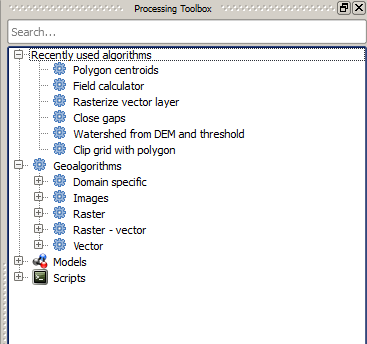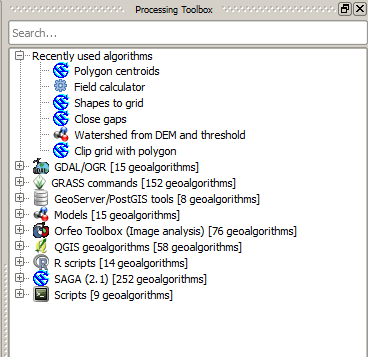17.3. プロセッシングフレームワークを構成する¶
プロセッシングフレームワークを使う前に環境設定をします。設定項目は多くないので簡単です。
その後、我々は、利用可能なアルゴリズムのリストを拡張するために使用されている外部アプリケーションを構成する方法を示しますが、今は我々だけでフレームワーク自体で作業しようとしています。
The processing framework is a core QGIS plugin, which means that, if you are running QGIS 2.0, it should already be installed in your system, since it is included with QGIS. In case it is active, you should see a menu called Processing in your menu bar. There you will find an access to all the framework components.

メニューを見つけられない場合、プラグインマネージャでそれを有効にすることで、プラグインを使用可能にする必要があります。

The main element that we are going to work with is the toolbox. Click on the corresponding menu entry and you will see the toolbox docked at the right side of the QGIS window.

ツールボックスはすべての利用可能なアルゴリズムのリストを含み、グループで分けられています。構成するこれらのアルゴリズムを表示する方法は2つあります: advanced mode と*simplified* モードです。
By default, you will see the simplified mode, which groups algorithms according to the kind of operation they perform. Although some of the algorithms that you will see in the toolbox depend on other external applications (most of them do, in fact), you will not see any mention to those applications. The origin of algorithms is hidden in this mode, which is a facade that simplifies using algorithms through the processing framework.
Examples in this guide only use the simplified mode. The advanced mode has some additional features and algorithms, but it requires understanding the applications that are called, so they are a more advanced topic. Some of these more advanced ideas are introduced in the final lessons of this book, but for the rest of them we will just use the simplified interface.
ツールボックスの一部で、ボタンを使って通常モードと上級者モードの変更ができます。
上級者トモードで使用する場合、ツールボックスはこのように見えます。

If you have reached this point, now you are ready to use geoalgorithms. There is no need to configure anything else by now. We can already run our first algorithm, which we will do in the next lesson.